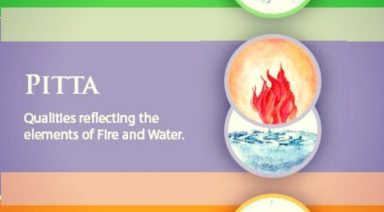The Science of Suffering: Understanding the 5 Kleshas and What They Really Mean

For most of us, life is pretty simple when we’re born. Our needs are met. Our concerns are only essential. Our world is new, beautiful, and engaging. And, most importantly, we are connected to the source of the universe, enjoying a direct line to love. In the profound teachings in A Course in Miracles, one of the most foundational beliefs is that when you are connected to this source your life is good, miraculous in fact. But, when separated from it, life is painful and complicated; you are overwhelmed with the feeling of being lost.
In Patanjali’s Yoga Sutras, another equally profound book of wisdom, the concept of being separated from the universal source of love is broken down into five identifiable roots of suffering. Known as the kleshas, these roots are what keep us away from love and, therefore, are what cause us to suffer.
By understanding the science of suffering by digging into these kleshas, you can begin to become aware of what is keeping you from enjoying life, what is keeping you from knowing, as the yogis say, your true nature.
Breaking Down the Five Kleshas
Although you may have heard the Sanskrit words in yoga class or have briefly studied them in a teacher training or college course, chances are that many of us haven’t actually sat down to meditate on what they really mean. But, by doing so, you make yourself aware of your daily actions, recognizing when you are acting or thinking from a place of fear or misunderstanding.
- Defined simply as “ignorance,” avidya is one of the most important kleshas because it fuels the other four. The simple act of being separated from the source of love, and not recognizing that you have or trying to reconnect, is avidya in action.
- Although not commonly referred to asmita outside of the yoga world, the concept of ego is. Being aware of your desire to think as “I” allows you to realize again this separation from universal love. When you believe in asmita, you believe that you are separate from others, a feeling that fuels negative and corrosive emotions like jealousy and judgment.
- Translated to mean “attachment,” raga is pervasive in the majority of our day to day lives. The desire to control things or to keep everything the same is so common that people write it off as human nature. Learning how to let go, however, and finding ways to accept the outcome, to be present with what is, is the only way to end daily suffering.
- Why don’t you like the way something turned out? It’s because you are attached to the outcome. This aversion, also known as dvesha, is intertwined with raga; you can’t have one without the other. While the two are burdensome, the fact that they are two sides of the same coin means that by taking care of one you rid yourself of the other.
- Finally, there’s the desire to cling to life. Abhinivesha, of all the kleshas, is one of the most difficult to free yourself from. Because life is miraculous and beautiful, and because you love your people in life, learning to accept that life ends can be a real struggle, especially when it feels like it’s not happening when you’re ready. Achieving freedom from abhinivesha can only come when you are aware of and understand the dangers of the other four kleshas. Once you have a handle on the other four, learning to not cling to life is the only natural progression, and a freeing one at that.
Start with Ignorance

Take some time to sit with the kleshas and you begin to realize that the order they appear in, one through five, is both logical and practical. In order to make progress with any of them, you must first understand that the root of all suffering begins with ignorance, avidya. Ego, attachment, aversion, and your desire to cling to life all come from a misunderstanding about the universe, a confusion about what is reality and what is not.
The goal, however, isn’t to get rid of any of them for good. Just as meditation’s goal isn’t to be completely free from thoughts, ending suffering is a constant decision to choose to focus on what is real, rather than what is not.
Falling down the rabbit hole of any of the five, or all five, kleshas is ignorance in play.
Will you make judgments about others during the day?
Will you feel upset when something doesn’t turn out the way you want?
Will you think of yourself as superior or better than someone else?
Of course.
Anyone who has spent time in meditation understands that the subconscious brain is an expert at producing thoughts without your consent. In order to be present you must learn to not identify with them. Instead, you must learn to simply observe.
The same is true with the kleshas.
Freeing yourself from suffering all begins when you realize that reality doesn’t revolve around any of these five kleshas, and that life isn’t defined by them.
Where to Begin

Life isn’t black and white, although we often want to think of it like it is. In a black and white world, we’re controlled by the desire to avoid pain and seek pleasure. In fact, we start to live by dividing everything into these two categories. This way of thinking though underestimates the complex nature of the universe.
In the universe, nothing is black or white. Nothing exists only in one plane.
How do we begin to recognize this miraculous nature? How do we begin to trust in the beauty and plan of the universe, letting go of control, and discovering how to tap back in to the cosmic source of love?
- By practicing meditation, you learn the subtle art of observation and how it allows you to move into the present. It’s for this reason that meditation is so essential to freeing yourself from the suffering of the kleshas. When you learn to observe your life and your thoughts from a place that doesn’t identify with the “I” nature, you enter a state where you can eradicate the kleshas.
- Practice Pranayama. For many students of yoga, the practice revolves around asana, the poses. And while the poses are beneficial, they are designed to prepare your mind and body for meditation and are so crucial to breaking free from the kleshas. Pranayama gives you the ability to directly tap into the source of the universe, to the universal love that you have separated from.
- Whether you move in the form of sun salutations, go for a hike, or simply make a decision, moving gives you the opportunity to be free. Fear doesn’t exist when you’re taking action.
Next time you’re around a young child or baby, take a moment to observe. Look closely at the joy in their eyes, at their ability to be present, and you’ll be reminded of what being connected to love feels like.
In the words of Gabrielle Bernstein, “When you’re in harmony with love, you receive more of what you want.” Just as the kleshas can lead you on a dangerous cycle of suffering, love can take you on a beautiful path of joy, fulfillment, and a life you truly love.
How to Live with Purpose: The Eight Paths of Yoga

The word yoga is translated literally as union but there are so many different forms, types and practices in yoga that it can often seem confusing. Although the eight limbs of yoga and the eight paths of yoga sound similar, it’s important to differentiate them.
The eight limbs of yoga is explained in Patanjali’s Yoga Sutras as an eightfold path called ashtanga, which means eight limbs (ashta= eight, anga= limb). These limbs are suggestions for living a life full of purpose and meaning. They act as a compass for self-discipline, integrity, and connecting to the divine within ourselves as well as the world around us. They are: yamas, niyamas, asana, pranayama, pratyahara, dharana, dhyana and Samadhi.
The eight paths or forms of yoga are Hatha, Bhakti, Jnana, Karma, Tantra, Raja, Kriya, and Kundalini.
The eight paths or forms of yoga each incorporate at least one or more of the eight limbs of yoga. All forms are practices to accelerate the process of yoga, or what the Bhagavad Gita refers to as, “the science of creating union between the Individual Consciousness with the Ultimate Consciousness.”
Each yogic path essentially is a set of practices designed for a certain type of practitioner. While Karma yoga uses action and service, Bhakti yoga focuses on love and devotion as means of attaining union. Raja yoga is known as the yoga of concentration and Jnana yoga is the yoga of knowledge.
Different from the branches of yoga, explained in Ashtanga, the eight paths each have a unique history and origination. As a yoga practitioner, you might want to review the origin and meaning of each, try the exercises below and journal or meditate on the answers to determine which form you will choose to explore next. Remember, you can only master so many forms in a lifetime.





































